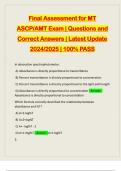Summary
samenvatting Hoofdstuk 2 + 3 : chemistry of life en cel structuur en functie,van biologie en ziekteleer
- Course
- Institution
Dit is een uitgebreide samenvatting van hoofdstuk 2 en 3 van het vak biologie en ziekteleer. Er zit daarnaast ook een inhoudsopgave bij als geheugensteun voor deze hoofdstukken. in het Nederlands samengevat.
[Show more]












